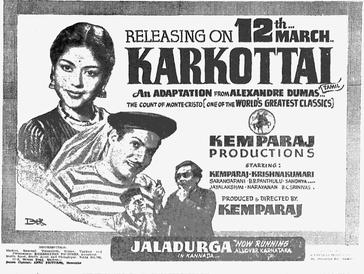“Jaladurga” is a classic Kannada film released in 1954, directed by the eminent H. L. N. Simha, who was well-known for his contributions to Kannada cinema. The film stars B. Saroja Devi, Narasimharaju, and G. V. Iyer, among others. It is celebrated for its engaging storyline, memorable performances, and cultural significance.
The plot of “Jaladurga” revolves around a dramatic tale set in a kingdom named Jaladurga, which translates to “Fortress of Water.” The film weaves a narrative that combines elements of romance, adventure, and social issues, reflecting the cinematic trends of the time.
B. Saroja Devi plays the lead role of the princess of Jaladurga. Her character is a blend of grace, intelligence, and bravery, making her a central figure in the story. The princess is deeply loved by the people of Jaladurga for her benevolent nature and strong sense of justice. Her portrayal in the film showcases her journey as she navigates the challenges posed by both internal court politics and external threats to her kingdom.
Narasimharaju, renowned for his comedic talent, provides comic relief in the film. His character is a loyal and witty companion to the princess, adding humor and light-hearted moments to the otherwise intense narrative. His performance is crucial in balancing the film’s serious and adventurous tones, ensuring that the audience remains entertained throughout.
G. V. Iyer plays the role of the main antagonist, a cunning and ambitious courtier who seeks to usurp the throne of Jaladurga. His character is a portrayal of treachery and deceit, representing the internal threats faced by the kingdom. The conflict between the princess and the antagonist forms the crux of the film’s plot, driving the narrative forward.
As the story unfolds, the princess embarks on a quest to protect her kingdom from the villain’s schemes. She is supported by a group of loyalists who believe in her vision and leadership. The film delves into themes of loyalty, bravery, and the struggle for justice, highlighting the moral and ethical dilemmas faced by the characters.
The direction by H. L. N. Simha ensures that “Jaladurga” remains a captivating watch. The narrative is tightly woven, with well-developed characters and a plot that keeps the audience engaged. The film effectively uses dramatic and scenic visuals to depict the grandeur of the kingdom and the intensity of the unfolding events.
The music of “Jaladurga,” composed by B. R. Lakshman Rao, plays a significant role in enhancing the film’s atmosphere. The songs are melodious and well-integrated into the storyline, reflecting the emotional and cultural contexts of the scenes. The musical score adds depth to the narrative, underscoring key moments and elevating the overall impact of the film.
In conclusion, “Jaladurga” is a significant film in the annals of Kannada cinema, remembered for its engaging storyline, strong performances, and the cultural values it portrays. The film’s exploration of themes like loyalty, justice, and bravery, combined with its rich narrative and memorable music, ensures that it continues to be cherished by audiences as a timeless classic


